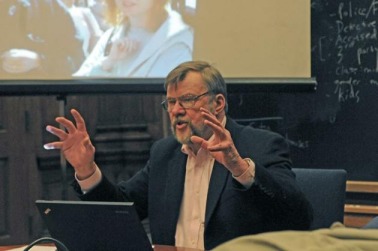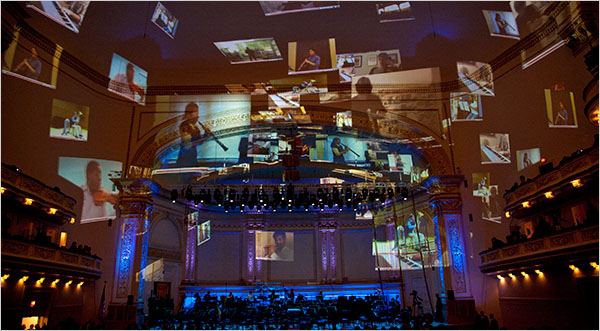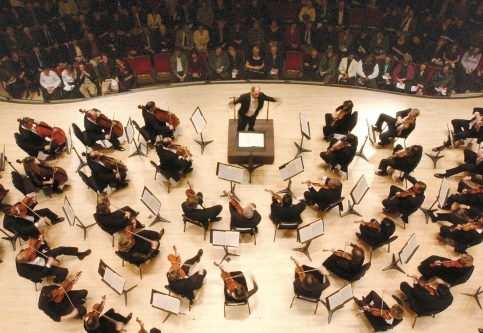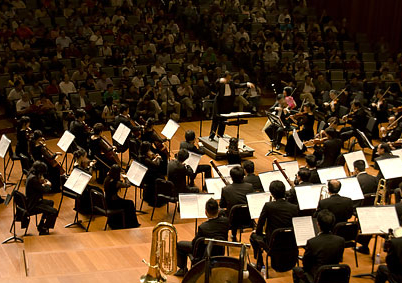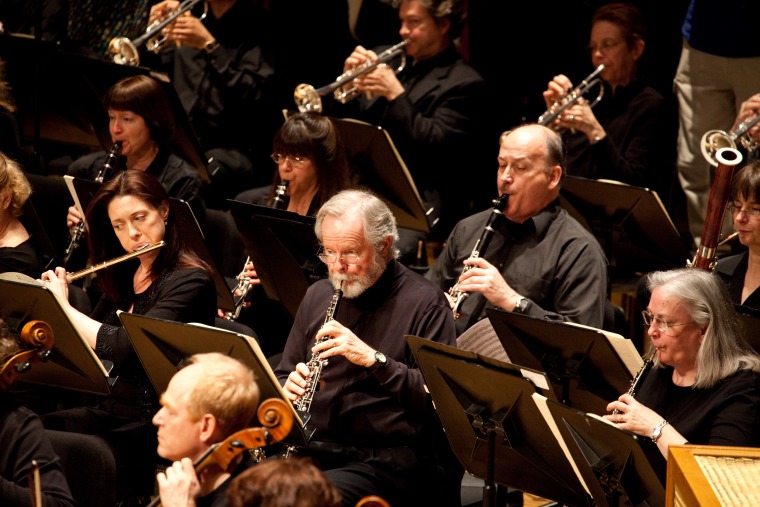In Memoriam: Richard Hackman, 1940 – 2013
January 21, 2013I met Erin Lehman and Richard Hackman back in the mid-90s when they brought their research to ROPA conferences. I remember having a long talk with Richard in Ottawa at the second “Unity” conference, about the future of orchestras and what we could do to change the culture. When Erin sent me word that Richard had passed away on January 8, 2013, I asked her to write a memorial for Polyphonic, explaining why he was so important and so revered in the orchestra world. Richard’s Harvard colleagues have put up a memorial website: www.jrichardhackman.com
Orchestras at a Crossroads
June 25, 2011Remarks by Jesse Rosen, President and CEO, League of American Orchestras, at the “Red Alert” plenary session at the 66th National Conference, Minneapolis, June 8, 2011.
Michael Kaiser's Arts in Crisis Symposium
June 11, 2010Michael Kaiser, CEO of the Kennedy Center, has been touring the country, visiting all 50 states (69 cities all-together – New Haven CT was number 58), offering his advice about how arts organizations can weather the current economic downturn. Thursday, June 10, 2010 was his day to be in Connecticut – he gave two presentations: one at the Yale Art Gallery in New Haven and one at St. Joseph’s College in West Hartford. The session was moderated by Diane Smith, a well-known CT television and radio personality who has recently done a lot of award-winning work with CT public television.
Michael Kaiser has been called “the turnaround king” because of his success with several arts organizations, including the Kansas City Ballet, Alvin Ailey American Dance Theater, American Ballet Theater, and London’s Royal Opera House. Indeed, his 2008 book is titled The Art of the Turnaround: Creating and Maintaining Healthy Arts Organizations.
In 2001, Michael created the Kennedy Center Arts Management Institute to provide advanced training for young arts administrators, and has developed a series of programs to help train others in the field. He created a Capacity Building Program for Culturally Specific Arts Organizations, which offers mentoring services to the leaders of African-American, Latino, Asian-American and Native-American arts groups across the United States. In February 2009, he created Arts in Crisis: A Kennedy Center Initiative, a program that has provided free arts management consulting to 650 arts organizations around the US.
While he has some very serious advice to offer, he is also very entertaining and inspiring. Many of the points he made in his talk this morning are discussed in much greater detail in his book, but this article provides a summary of some of his main points. (Comments in quotes are in first person and are close to what Michael or Diane actually said, but may not be verbatim.)
Diane started the session off with a big laugh as she complimented him on his wonderful photo on the cover of his book. (It’s actually a very striking photo of a dancer from the Alvin Ailey troupe!)
Organizational Culture: Metaphor
January 29, 2009If you have read the “about us” area of this website, you know that our roots are with an organization that was founded by Paul R. Judy in 1994—the Symphony Orchestra Institute. As a successful businessman with a keen interest in music and symphony orchestras, Mr. Judy created the SOI with the particularly interest and dedication to improve the effectiveness of symphony orchestra organizations. His interest in organizational change led him to commission Laura Roelofs to write a series of eight articles for the web version of the SOI journal Harmony. The articles describe various approaches to understanding and implementing organization change.
Today Polyphonic begins presenting this series again, and will publish one article every two weeks. But to start us off, and since seven years have elapsed since Laura published the first article on the subject, we asked her to bring us up to date with recent trends in the field.
Organizational Culture: Change Process
If you have read the “about us” area of this website, you know that our roots are with an organization that was founded by Paul R. Judy in 1994—the Symphony Orchestra Institute. As a successful businessman with a keen interest in music and symphony orchestras, Mr. Judy created the SOI with the particularly interest and dedication to improve the effectiveness of symphony orchestra organizations. His interest in organizational change led him to commission Laura Roelofs to write a series of eight articles for the web version of the SOI journal Harmony. The articles describe various approaches to understanding and implementing organization change.
Today Polyphonic begins presenting this series again, and will publish one article every two weeks. But to start us off, and since seven years have elapsed since Laura published the first article on the subject, we asked her to bring us up to date with recent trends in the field.
Organizational Culture
If you have read the “about us” area of this website, you know that our roots are with an organization that was founded by Paul R. Judy in 1994—the Symphony Orchestra Institute. As a successful businessman with a keen interest in music and symphony orchestras, Mr. Judy created the SOI with the particularly interest and dedication to improve the effectiveness of symphony orchestra organizations. His interest in organizational change led him to commission Laura Roelofs to write a series of eight articles for the web version of the SOI journal Harmony. The articles describe various approaches to understanding and implementing organization change.
Today Polyphonic begins presenting this series again, and will publish one article every two weeks. But to start us off, and since seven years have elapsed since Laura published the first article on the subject, we asked her to bring us up to date with recent trends in the field.
Open Systems Applied
If you have read the “about us” area of this website, you know that our roots are with an organization that was founded by Paul R. Judy in 1994—the Symphony Orchestra Institute. As a successful businessman with a keen interest in music and symphony orchestras, Mr. Judy created the SOI with the particularly interest and dedication to improve the effectiveness of symphony orchestra organizations. His interest in organizational change led him to commission Laura Roelofs to write a series of eight articles for the web version of the SOI journal Harmony. The articles describe various approaches to understanding and implementing organization change.
Today Polyphonic begins presenting this series again, and will publish one article every two weeks. But to start us off, and since seven years have elapsed since Laura published the first article on the subject, we asked her to bring us up to date with recent trends in the field.
Open System Concepts
If you have read the “about us” area of this website, you know that our roots are with an organization that was founded by Paul R. Judy in 1994—the Symphony Orchestra Institute. As a successful businessman with a keen interest in music and symphony orchestras, Mr. Judy created the SOI with the particularly interest and dedication to improve the effectiveness of symphony orchestra organizations. His interest in organizational change led him to commission Laura Roelofs to write a series of eight articles for the web version of the SOI journal Harmony. The articles describe various approaches to understanding and implementing organization change.
Today Polyphonic begins presenting this series again, and will publish one article every two weeks. But to start us off, and since seven years have elapsed since Laura published the first article on the subject, we asked her to bring us up to date with recent trends in the field.
More Recent Developments: Branches and Blossoms
If you have read the “about us” area of this website, you know that our roots are with an organization that was founded by Paul R. Judy in 1994—the Symphony Orchestra Institute. As a successful businessman with a keen interest in music and symphony orchestras, Mr. Judy created the SOI with the particularly interest and dedication to improve the effectiveness of symphony orchestra organizations. His interest in organizational change led him to commission Laura Roelofs to write a series of eight articles for the web version of the SOI journal Harmony. The articles describe various approaches to understanding and implementing organization change.
Today Polyphonic begins presenting this series again, and will publish one article every two weeks. But to start us off, and since seven years have elapsed since Laura published the first article on the subject, we asked her to bring us up to date with recent trends in the field.
Growth and Development
If you have read the “about us” area of this website, you know that our roots are with an organization that was founded by Paul R. Judy in 1994—the Symphony Orchestra Institute. As a successful businessman with a keen interest in music and symphony orchestras, Mr. Judy created the SOI with the particularly interest and dedication to improve the effectiveness of symphony orchestra organizations. His interest in organizational change led him to commission Laura Roelofs to write a series of eight articles for the web version of the SOI journal Harmony. The articles describe various approaches to understanding and implementing organization change.
Today Polyphonic begins presenting this series again, and will publish one article every two weeks. But to start us off, and since seven years have elapsed since Laura published the first article on the subject, we asked her to bring us up to date with recent trends in the field.

